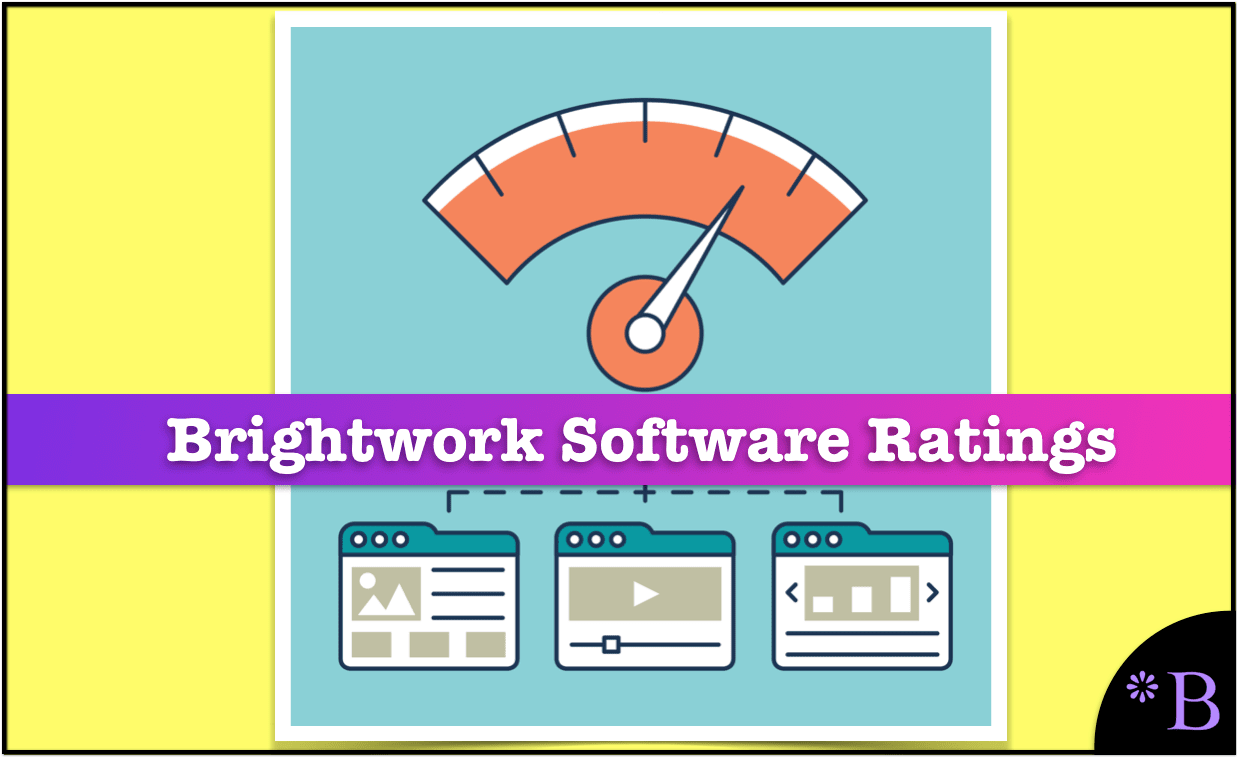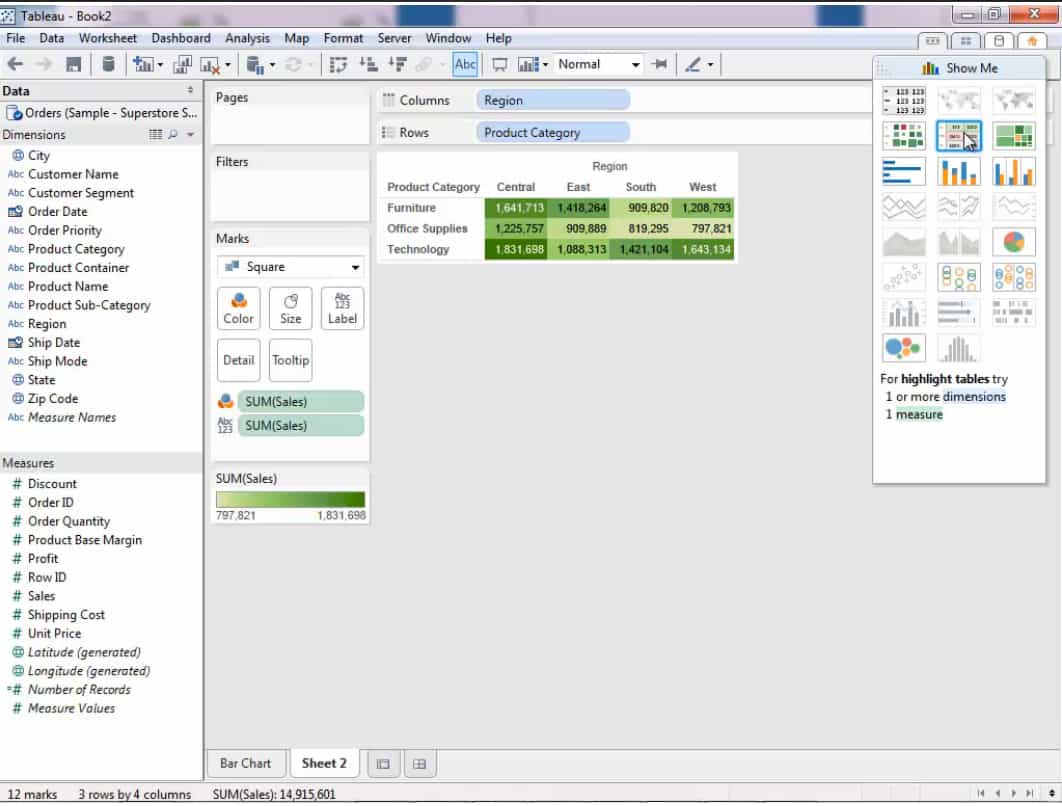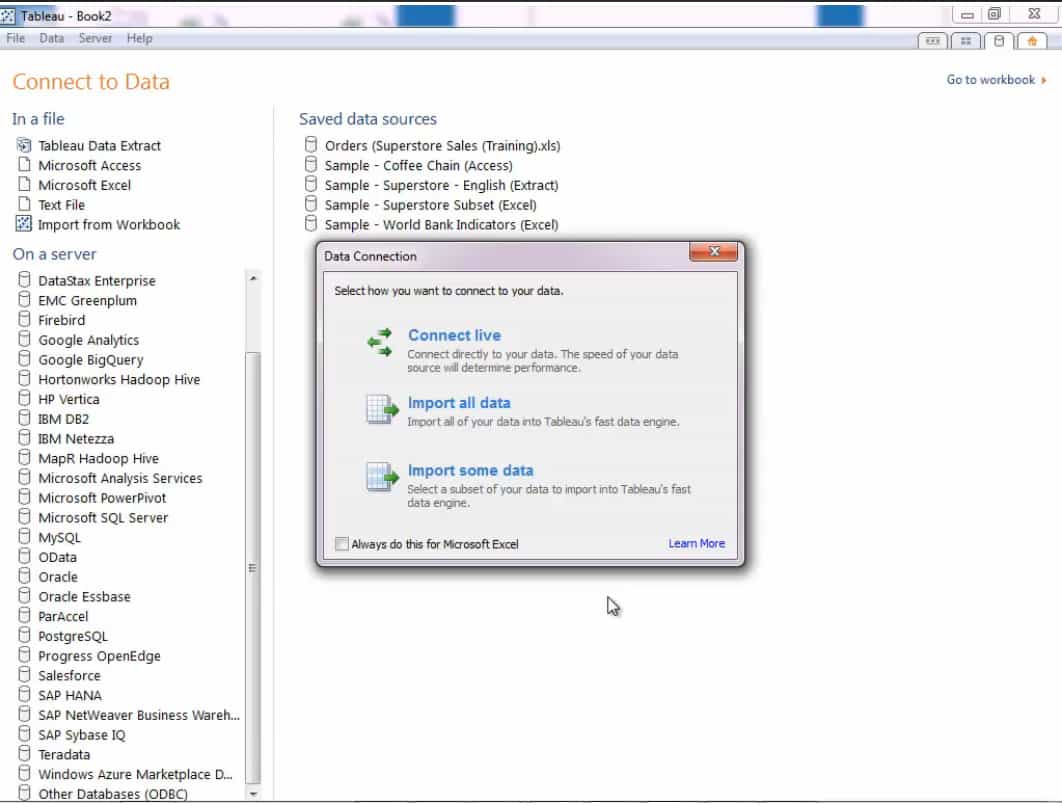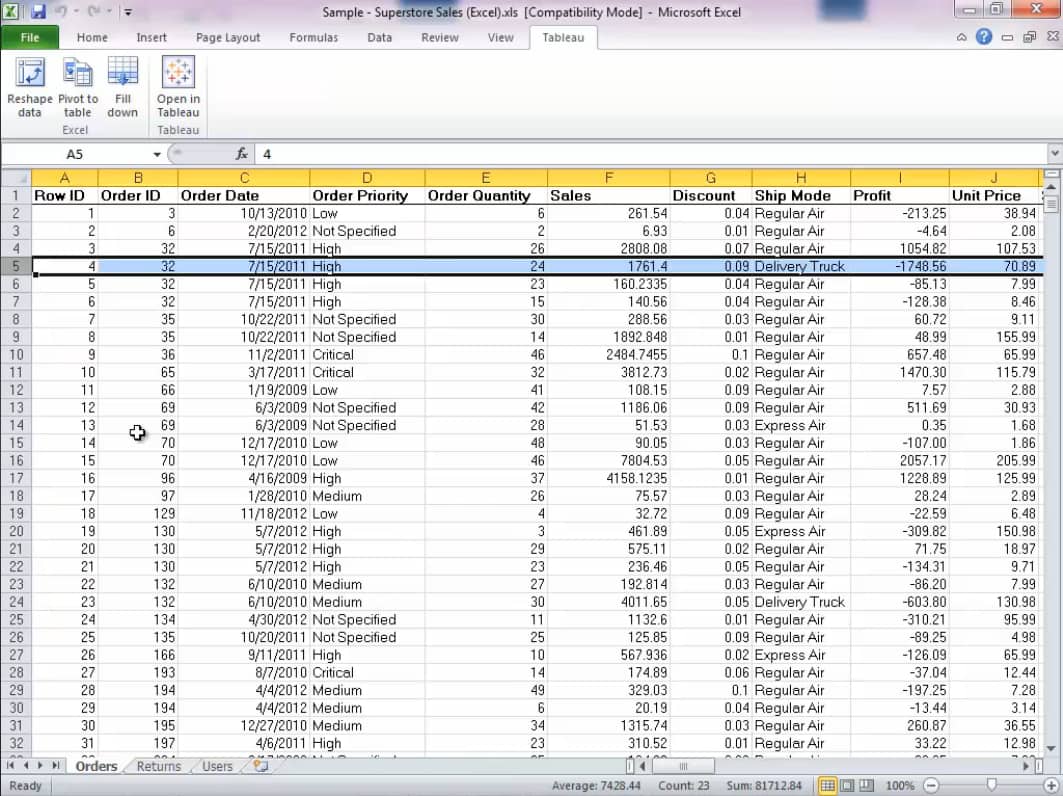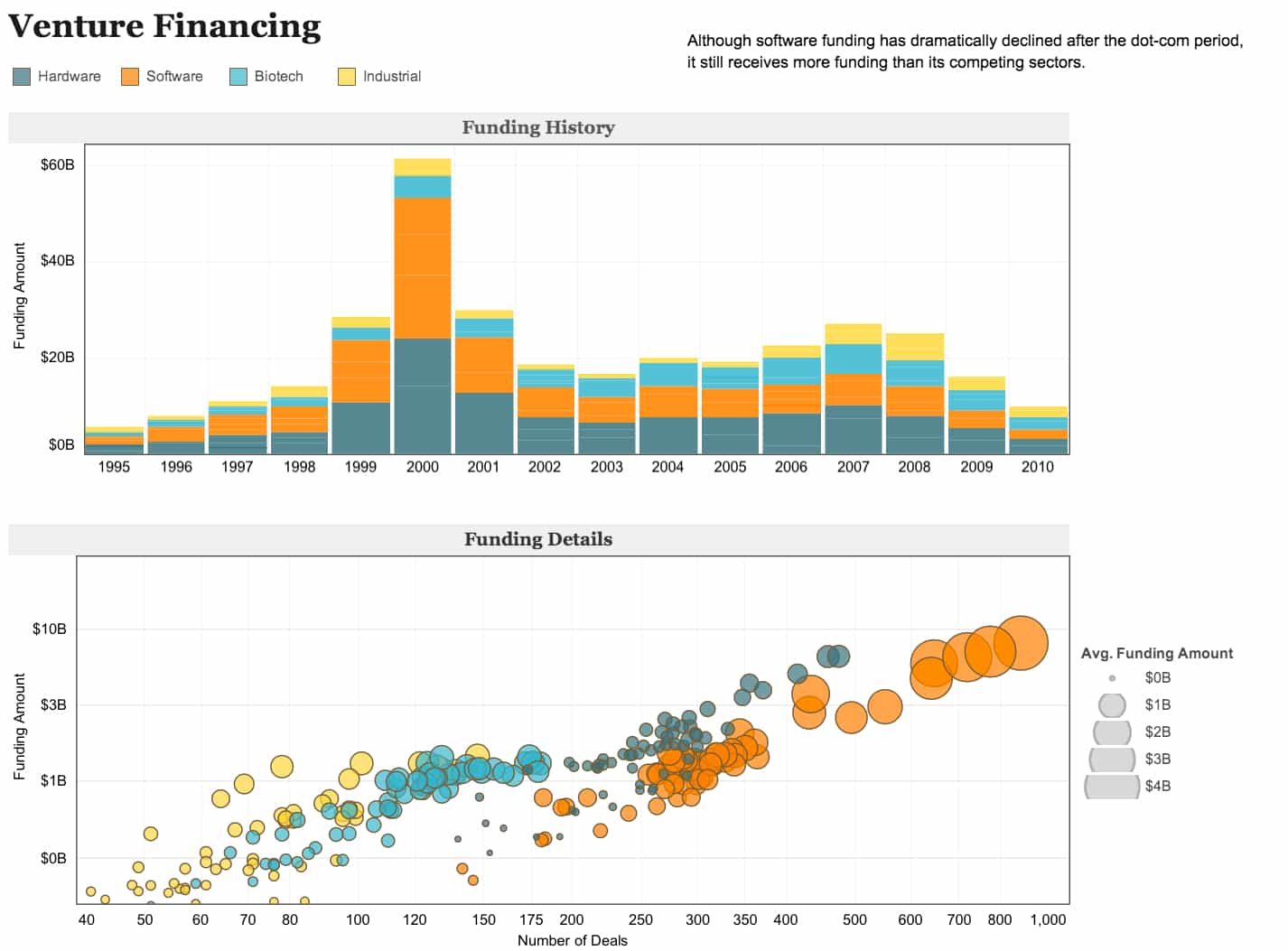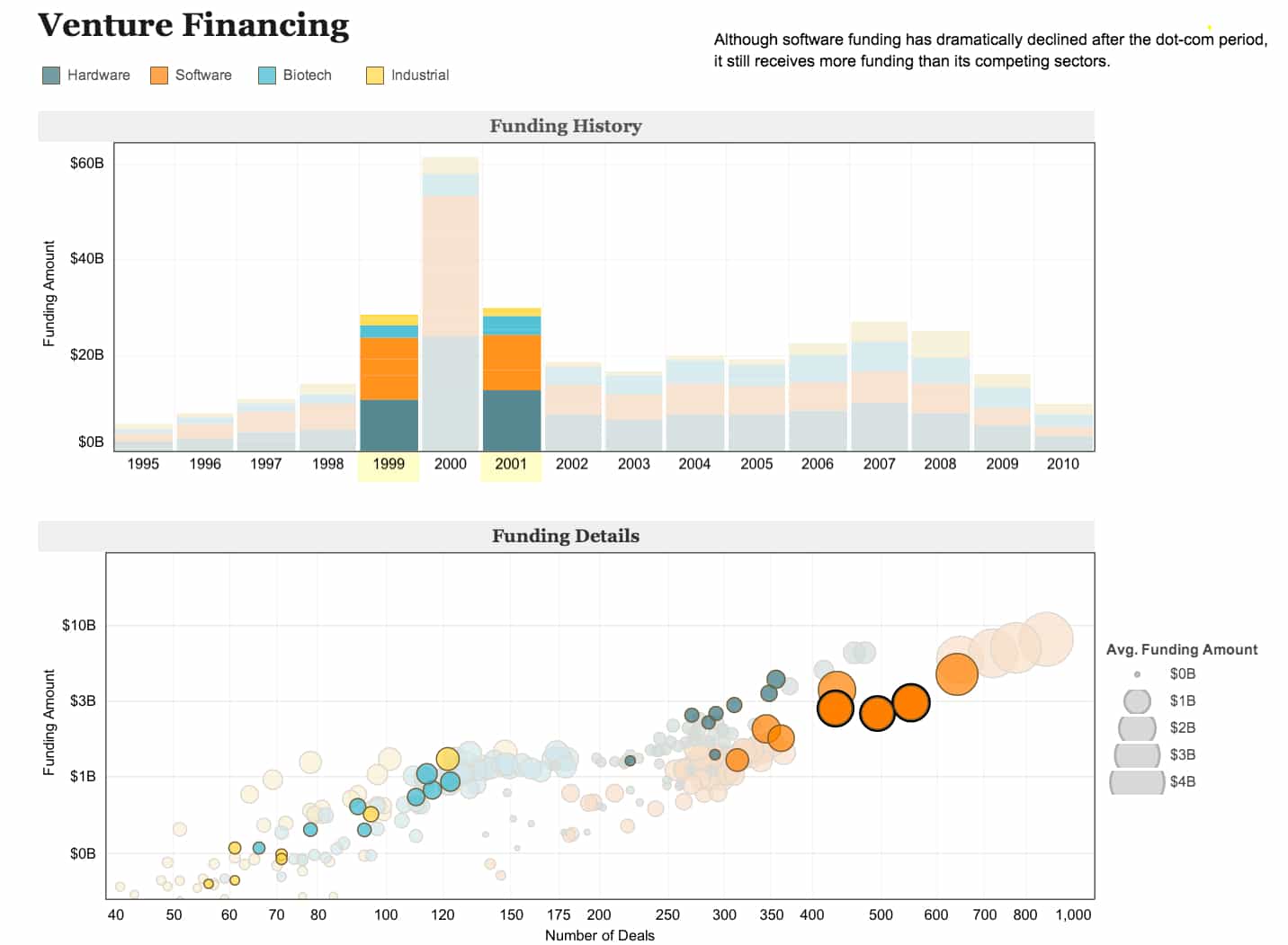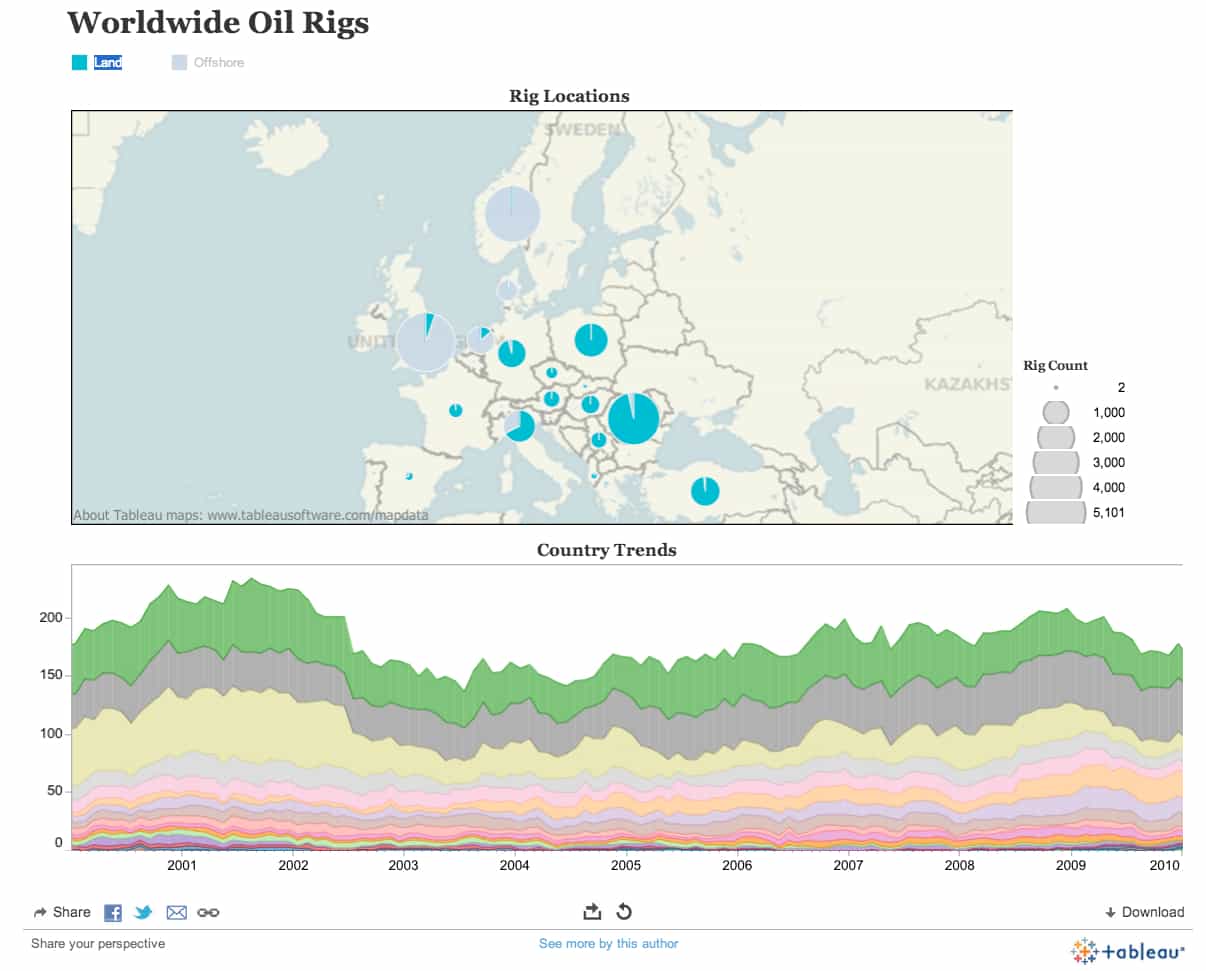Executive Summary
- This is the Brightwork Research & Analysis software rating series.
- We rate both the software and estimate the risk of implementing each application.
MUFI Rating & Risk – Tableau (BI)
MUFI: Maintainability, Usability, Functionality, Implement ability
Vendor: Tableau (Select For Vendor Profile)
Introduction
Tableau is a very similar application to QlikView — in some ways. Tableau does a very good job in the BI areas that it covers, but Tableau only covers around ½ of the complete BI functionality, and it is the premier BI Light application.
Tableau has only three offerings – a rarity in BI where vendors tend to offer a variety of applications that are often quite confusing. Tableau offers Tableau Desktop, Tableau Server, and Tableau Online – their cloud/SaaS offering. However, while they are the distinct offerings regarding how they are priced, and only Tableau Server and Tableau Online are the “full” product, they are all upgraded on the same cycle.
Application Detail
Tableau makes in our opinion the most exciting application in the BI space, and along with QlikView, it has the highest buyer satisfaction level in the BI software category. Tableau is easily the user adoption leader, with users preferring Tableau over any other BI application by a wide margin.
Tableau’s are in our opinion the best application ever developed for analytics. Many of the changes are so simple they are effortless. For instance, with the data of Region in the Column entry and Product Category in the Row entry, the graphics that are applicable are colored, while those that are not applicable are greyed out. Dimensions and Measures may be easily pulled from the left window pane and dragged to a variety of locations – much like the PivotTable functionality in Excel. Switching between different report types is quite easy.
Tableau is a downloadable application but in 2013 Tableau offered a SaaS-based solution.
Tableau does an excellent job of both connecting to multiple data sources and quickly uploading this information. The types of data sources Tableau can connect to continues to expand.
Sometimes it’s easy to forget that BI will often just connect to a spreadsheet. Sometimes a flat file is all that is required.
Some of the commentaries regarding the speed of Tableau raises eyebrows.
Some BI applications claim to have the ability to create stunning reports, but Tableau is one of the few that does. Many of the reports we have seen created in Tableau deliver the ultimate objective of any analytical medium, in that they transit educational knowledge.
Tableau allows just portions of the report to be selected, which provides targeted information on just the on the item selected.
Tableau reports allow for precise detail, which allows in-depth views into detail. This type of report is groundbreaking, and the interfaces provided by Tableau is highly articulated.
Tableau works very well with mapping, in fact, the best we have seen. This report efficiently shows a huge number of hurricanes, their location and their severity for 2005.
This report taught us which countries have the most land-based oil rigs.
We were quickly able to switch this report to show the offshore rigs, and from here it became apparent that the UK and Norway are the major European offshore oil companies.
We have learned quite a bit from various Tableau reports, both those created by Tableau for marketing purposes as well as those produced by clients that we interview. Tableau seems to have the ability to show information in a way that other BI applications cannot match. Although QlikView is close on their tails in this regard.
It should be recognized that these are sample reports from Tableau, and put together by very highly skilled Tableau resources – and the average Tableau report will be less impactful on average than these. However, users report also being quite satisfied with the daily reports that they can create with Tableau.
Something very interesting about Tableau is that they are getting into forecasting software. Forecasting relies upon a business intelligence back end and is a primary reason that the software vendor SAS is prominent in both forecastings as well as business intelligence. We cover this in our Software Selection Package for Demand Planning.
Tableau is growing faster than any other BI software vendor because of the strength of its application. We see the possibility of Tableau becoming a standard for advanced analysis to a smaller degree than Excel is today – and think the release of a less expensive desktop version of the application – with some disabled functionality would be a fine idea. Tableau is an application, which will continue to grow, benefiting from the overall growth of BI market, but also taking business, particularly from some of the large and inefficient BI applications.
Much is stated about the usability of Tableau, and the term “self-service” is an appealing term and easy to throw around as it is such a desirable objective. However, Tableau is not Excel, (although people with a significant amount of PivotTable experience will have a leg up in using the application) and requires training.
So one should not carry away with its user interface. In recorded videos, Tableau appears amazingly easy to use, however, that is in the hands of an experienced Tableau resource. The application has a high ceiling, but to do the types of powerful analytics that Tableau has become known for, it’s best if a superuser is assigned to help other business users build the reports that they need.
MUFI Scores
All scores out of a possible 10.
MUFI Scores
- Ma. = Maintainability
- Us. = Usability
- Fu. = Functionality
- Im. = Implementability
| App | Ma. | Us. | Ft. | Im. | Cat. |
|---|---|---|---|---|---|
| Average Score for Big ERP | 5.1 | 4.8 | 5.2 | 5.4 | Big ERP |
| Average Score for CRM | 6.2 | 6.2 | 5.1 | 5.9 | CRM |
| Average Score for Small and Medium ERP | 8.3 | 8 | 6.7 | 8.5 | Small and Medium ERP |
| Average Score for Finance | 8.8 | 8.8 | 8 | 8.8 | Finance |
| Average Score for Demand Planning | 7.6 | 7.2 | 7 | 7.1 | Demand Planning |
| Average Score for Supply Planning | 6.7 | 6.9 | 7 | 6.8 | Supply Planning |
| Average Score for Production Planning | 6.8 | 6.9 | 7 | 6.9 | Production Planning |
| Average Score for BI Heavy | 5.5 | 5.3 | 6.9 | 5.3 | BI Heavy |
| Average Score for PLM | 7 | 7.2 | 6.8 | 7.3 | PLM |
| Average Score for BI Light | 7.7 | 8.7 | 9 | 8.3 | BI Light |
| Arena Solutions Arena PLM | 10 | 10 | 10 | 10 | PLM |
| AspenTech AspenOne | 4 | 8 | 10 | 7 | Production Planning |
| Birst | 8 | 8.5 | 10 | 8 | BI Light |
| ERPNext | 10 | 10 | 7.5 | 10 | Small and Medium ERP |
| Delfoi Planner | 8 | 6 | 6.5 | 7 | Production Planning |
| Demand Works Smoothie SP | 9 | 10 | 7 | 10 | Supply Planning |
| Hamilton Grant RM | 10 | 9 | 8.5 | 9 | PLM |
| IBM Cognos | 2.7 | 3 | 1.5 | 3 | BI Heavy |
| Infor Epiphany | 7 | 8 | 6 | 5 | CRM |
| Infor Lawson | 8 | 7 | 6 | 7 | Big ERP |
| Intuit QuickBooks Enterprise Solutions | 9 | 9 | 5 | 9 | Finance |
| JDA DM | 9 | 7.5 | 8 | 8 | Demand Planning |
| Microsoft Dynamics CRM | 2 | 3 | 2 | 2 | CRM |
| NetSuite CRM | 6 | 4 | 3 | 3 | CRM |
| Netsuite OneWorld | 7 | 7 | 8 | 8 | Big ERP |
| OpenERP | 7 | 8 | 8.5 | 8 | 7 |
| Oracle BI | 4 | 4 | 3 | 6 | BI Heavy |
| Oracle CRM On Demand | 4 | 5 | 3 | 5 | CRM |
| Oracle Demantra | 5 | 3 | 3.5 | 4.5 | Demand Planning |
| Oracle JD Edwards World | 4 | 1 | 3 | 6 | Big ERP |
| Oracle RightNow | 6 | 7 | 4 | 5 | CRM |
| PlanetTogether Galaxy APS | 10 | 10 | 10 | 10 | Production Planning |
| Preactor | 8 | 7 | 3 | 7 | Production Planning |
| QlikTech QlikView | 9 | 9 | 10 | 9 | BI Light |
| Rootstock | 9 | 8 | 9 | 9 | Small and Medium ERP |
| Sage X3 | 8 | 8 | 7 | 8 | Big ERP |
| Salesforce Enterprise | 8 | 8.5 | 9 | 7.5 | CRM |
| SAP APO DP | 3 | 4 | 3 | 2 | Demand Planning |
| SAP APO PP/DS | 2 | 2 | 4 | 3 | Production Planning |
| SAP APO SNP | 3 | 4 | 8 | 4 | Supply Planning |
| SAP BI/BW | 1.5 | 2 | 4 | 2 | BI Heavy |
| SAP Business Objects | 3 | 2.5 | 7 | 3 | BI Heavy |
| SAP CRM | 4 | 3 | 6 | 4 | CRM |
| SAP ECC | 3 | 3 | 6.5 | 3 | Big ERP |
| SAP PLM | 1 | 2.5 | 2 | 3 | PLM |
| SAP SmartOps | 4 | 4 | 7 | 5.5 | Supply Planning |
| SAS BI | 6.5 | 7 | 9 | 6 | BI Heavy |
| SAS Demand Driven Forecasting | 7 | 8 | 9 | 7 | Demand Planning |
| Tableau (BI) | 9 | 10 | 10 | 10 | BI Light |
| Tableau (Forecasting) | 10 | 8 | 5 | 9 | Demand Planning |
| Teradata | 8 | 6.3 | 9.7 | 6 | BI Heavy |
| ToolsGroup SO99 (Forecasting) | 7 | 8 | 9 | 7 | Demand Planning |
| ToolsGroup SO99 (Supply) | 5 | 6 | 10 | 7 | Supply Planning |
Vendor and Application Risk
The only real issue with Tableau is that the application can seem to be so easy to use that the project ends up being understaffed. We explain in the BI category analysis that none of the BI applications are truly self-service. Users can be expected to make variations on previously created reports when they gain the experience, but should not be expected to create new reports, particularly original reports from scratch.
Likelihood of Implementation Success
This accounts for both the application and vendor-specific risk. In our formula, the total implementation risk is application + vendor + buyer risk. The buyer specific risk could increase or decrease this overall likelihood and adjust the values that you see below.
Likelihood of Application Implementation Success and Failure
Search for the application in this table using the search bar in the upper right of the table.
| Application | Prob of Implementation Success | Prob of Implementation Failure |
|---|---|---|
| Actuate | 0.77 | 0.23 |
| SAP Smartops | 0.39 | 0.61 |
| NetSuite CRM | 0.46 | 0.54 |
| Sugar CRM | 0.62 | 0.48 |
| Base CRM | 0.91 | 0.09 |
| SAP CRM | 0.35 | 0.65 |
| Salesforce Enterprise | 0.72 | 0.28 |
| QlikTech QlikView | 0.82 | 0.18 |
| Tableau (BI) | 0.98 | 0.02 |
| SAP Crystal Reports | 0.46 | 0.54 |
| Brist | 0.83 | 0.17 |
| MicroStrategy | 0.7 | 0.3 |
| SAS BI | 0.76 | 0.24 |
| Oracle BI | 0.35 | 0.65 |
| IBM Cognos | 0.23 | 0.77 |
| Infor Epiphany | 0.58 | 0.42 |
| Microsoft Dynamics CRM | 0.26 | 0.74 |
| Oracle RightNow CRM | 0.41 | 0.59 |
| Oracle CRM On Demand | 0.36 | 0.64 |
| Teradata | 0.76 | 0.24 |
| SAP Business Objects | 0.32 | 0.68 |
| SAP BI/BW | 0.25 | 0.75 |
| SAP PLM | 0.29 | 0.71 |
| Hamilton Grant RM | 0.89 | 0.11 |
| Arena Solutions | 0.96 | 0.04 |
| Delfoi Planner | 0.7 | 0.3 |
| Preactor | 0.64 | 0.36 |
| PlanetTogether Galaxy APS | 0.96 | 0.04 |
| AspenTech AspenOne | 0.55 | 0.45 |
| SAP APO PP/DS | 0.27 | 0.73 |
| Demand Works Smoothie SP | 0.93 | 0.07 |
| ToolsGroup SO99 (Supply) | 0.82 | 0.18 |
| Demand Works Smoothie | 0.96 | 0.04 |
| Tableau (Forecasting) | 0.9 | 0.1 |
| SAS Demand Driven Forecasting | 0.82 | 0.18 |
| ToolsGroup SO99 (Forecasting) | 0.86 | 0.14 |
| JDA DM | 0.57 | 0.43 |
| Oracle Demantra | 0.33 | 0.67 |
| SAP APO DP | 0.28 | 0.72 |
| FinancialForce | 0.92 | 0.08 |
| Intacct | 0.98 | 0.02 |
| Intuit QB Enterprise | 0.8 | 0.2 |
| ERPNext | 0.9 | 0.1 |
| OpenERP | 0.78 | 0.22 |
| Rootstock | 0.91 | 0.09 |
| ProcessPro | 0.93 | 0.07 |
| Microsoft Dynamics AX | 0.4 | 0.6 |
| SAP Business One | 0.49 | 0.51 |
| Sage X3 | 0.62 | 0.38 |
| Infor Lawson | 0.58 | 0.42 |
| Epicor ERP | 0.4 | 0.6 |
| Oracle JD Edwards World | 0.31 | 0.69 |
| Oracle JD Edwards EnterpriseOne | 0.36 | 0.64 |
| SAP ERP ECC/R/3 | 0.32 | 0.68 |
| NetSuite OneWorld | 0.65 | 0.35 |
Risk Definition
See this link for more on our categorizations of risk. We also offer a Buyer Specific Risk Estimation as a service for those that want a comprehensive analysis.
Risk Management Approach
Our staffing estimations in our Project Planning Package for Tableau provides the necessary guidelines to staff Tableau implementations, and these are based upon evaluating actual Tableau projects.
Finished With Your Analysis?
To go back to the Software Selection Package page for the BI Light software category. Or goto this link to see other analytical products for Tableau.
